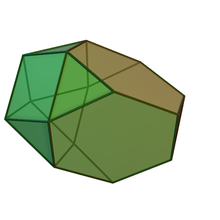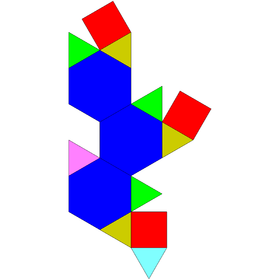Augmented truncated tetrahedron
| Augmented truncated tetrahedron | |
|---|---|
 | |
| Type | Johnson J64 – J65 – J66 |
| Faces | 8 triangles 3 squares 3 hexagons |
| Edges | 27 |
| Vertices | 15 |
| Vertex configuration | 2x3(3.62) 3(3.4.3.4) 6(3.4.3.6) |
| Symmetry group | C3v |
| Properties | convex |
| Net | |
 | |

In geometry, the augmented truncated tetrahedron is a polyhedron constructed by attaching a triangular cupola onto an truncated tetrahedron. It is an example of a Johnson solid.
Construction
[edit]The augmented truncated tetrahedron is constructed from a truncated tetrahedron by attaching a triangular cupola.[1] This cupola covers one of the truncated tetrahedron's four hexagonal faces, so that the resulting polyhedron's faces are eight equilateral triangles, three squares, and three regular hexagons.[2] Since it has the property of convexity and has regular polygonal faces, the augmented truncated tetrahedron is a Johnson solid, denoted as the sixty-fifth Johnson solid .[3]
Properties
[edit]The surface area of an augmented truncated tetrahedron is:[2] the sum of the areas of its faces. Its volume can be calculated by slicing it off into both truncated tetrahedron and triangular cupola, and adding their volume:[2]
It has the same three-dimensional symmetry group as the triangular cupola, the pyramidal symmetry . Its dihedral angles can be obtained by adding the angle of a triangular cupola and an augmented truncated tetrahedron in the following:[4]
- its dihedral angle between triangle and hexagon is as in the truncated tetrahedron: 109.47°;
- its dihedral angle between adjacent hexagons is as in the truncated tetrahedron: 70.53°;
- its dihedral angle between triangle and square is as in the triangular cupola's angle: 125.3°
- its dihedral angle between triangle and square, on the edge where the triangular cupola and truncated tetrahedron are attached, is the sum of both triangular cupola's square-hexagon angle and the truncated tetrahedron's triangle-hexagon angle: approximately 164.17°; and
- its dihedral angle between triangle and hexagon, on the edge where triangular cupola and truncated tetrahedron are attached, is the sum of the dihedral angle of a triangular cupola and truncated tetrahedron between that: approximately 141.3°;
References
[edit]- ^ Rajwade, A. R. (2001). Convex Polyhedra with Regularity Conditions and Hilbert's Third Problem. Texts and Readings in Mathematics. Hindustan Book Agency. p. 84–89. doi:10.1007/978-93-86279-06-4. ISBN 978-93-86279-06-4.
- ^ a b c Berman, Martin (1971). "Regular-faced convex polyhedra". Journal of the Franklin Institute. 291 (5): 329–352. doi:10.1016/0016-0032(71)90071-8. MR 0290245.
- ^ Francis, Darryl (August 2013). "Johnson solids & their acronyms". Word Ways. 46 (3): 177.
- ^ Johnson, Norman W. (1966). "Convex polyhedra with regular faces". Canadian Journal of Mathematics. 18: 169–200. doi:10.4153/cjm-1966-021-8. MR 0185507. S2CID 122006114. Zbl 0132.14603.
External links
[edit]




